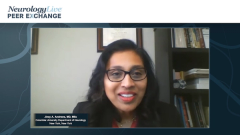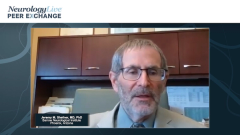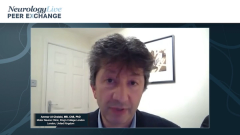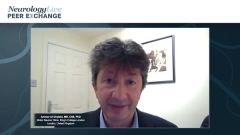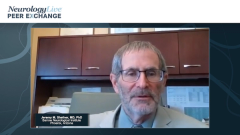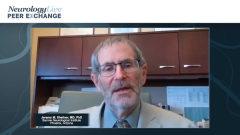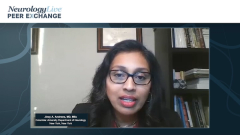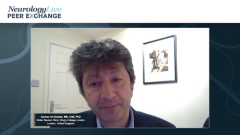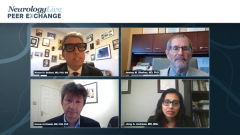
Diagnosing ALS: Signs and Symptoms
Expert neurologists discuss the variability of signs and symptoms as well as other factors to consider when diagnosing patients with amyotrophic lateral sclerosis (ALS).
Episodes in this series

Richard S. Bedlack, MD, PhD, MS: Ammar, you have seen a lot of folks with ALS [amyotrophic lateral sclerosis]. How do they typically present? What kinds of signs and symptoms do you have when they come to see you for the first time?
Ammar Al-Chalabi, MB, ChB, PhD: There are probably 3 main groups of presentation that are fairly common. The first is difficulty speaking or swallowing. It is usually a difficulty speaking, with slurred speech. Because of that, people may often go to see an ENT [ear, nose, and throat] specialist, a speech and language therapist, or a dentist because they think there is something wrong with their mouth.
Another fairly common presentation is difficulty with fine movement, particularly zips, buttons, keys, and locks, that kind of thing. Difficulty turning things can be an early presentation. Rather than having a distal presentation of the hand, some people can have a more proximal presentation with difficulty lifting objects above their head.
The third group is people with a dropped foot or difficulty walking. I would say those are the 3 main groups, symptomatically.
Richard S. Bedlack, MD, PhD, MS: Do we understand why people present in different ways with the same disease?
Ammar Al-Chalabi, MB, ChB, PhD: No. That is another mystery. Looking within families that have the same genetic variant causing ALS, you might think that they are going to present the same way, but not necessarily. Some genetic variants predispose you to present a particular way. For example, the C9orf72 expansion mutation that Jeremy mentioned makes you more likely to present with bulbar onset. Having an SOD1 mutation makes you more likely to present with a limb onset, but these are not hard and fast rules at all.
You can present with any of them. Roughly, 25% of people will present with a bulbar symptom, with difficulty speaking or swallowing, and the rest will present largely with limb weakness. Some people present with both, and about 1% of people present with difficulty breathing as their first symptom, so diaphragmatic weakness as the presentation. Of course, there are also nonmotor presentations, which are much more challenging, such as cognitive impairment. That kind of presentation will usually come to us after they have already had a diagnosis.
Richard S. Bedlack, MD, PhD, MS: Got it.
Jeremy M. Shefner, MD, PhD: There is old literature that suggests that, at least in some cases, the site of onset can be a site a previous injury. Many of the classical neurologists who may have trained many of us strongly believe that. Perhaps a crush injury to a foot was followed a year later by insidious weakness that started there, or maybe there was an electrical injury that caused an entry wound, and that could be the nidus for focal weakness that then spreads. Many of us have seen things like this, but making sense of that is quite difficult.
Richard S. Bedlack, MD, PhD, MS: Jinsy, I understand there is no simple diagnostic test for making an ALS diagnosis. How long does it typically take someone from symptom onset until the day that a doctor says this is what you have?
Jinsy A. Andrews, MD, MSc: The time to get diagnosed correctly with ALS can be pretty long, anywhere from 1 to 1 1/2 years, depending on the region, but it partly has to do with the fact that people with ALS look different from person to person, as we were talking about earlier. The presentation can look like someone who has slurred speech and may be suspected of having a stroke. Someone who has a foot drop may be suspected of having a back problem and may even get surgery to correct it.
There are a lot of mimics that look a lot like ALS when it presents early. Another major difficulty is that we do not have a diagnostic marker. I do not have a test that I can implement to say, “Yes, you definitely have ALS” or “No, you definitely do not have ALS.” That is the major issue. A smaller issue that affects that time to diagnosis is access to specialist care. The quicker we can identify a person who might be experiencing symptoms of ALS, the quicker we get them to the ALS specialist. Access is important in the diagnostic process.
The second issue is public awareness of the disease itself. I do not think it is in the front of mind of anybody when they have hand difficulty, speaking difficulty, or foot weakness, that ALS is the first thing that they think of. As we discussed earlier, the patients often present to other health care providers before coming to a neurologist even. These all contribute to delaying the diagnosis.
Richard S. Bedlack, MD, PhD, MS: Thank you. Ammar, do you think there are any consequences to this diagnostic delay of a year to a year and a half of symptoms before they can even be told they have this, much less get started on something? Is that a problem?
Ammar Al-Chalabi, MB, ChB, PhD: It is a problem, and it will get even worse as a problem. It is a problem because firstly, the uncertainty is difficult to deal with emotionally for many people. It is also a problem because, even though there is no definitive disease-altering treatment at the moment, there are still things that can be done to improve the quality of life for somebody affected. That delay has that direct consequence.
There is also the impact on other family members and the general anxiety. It is important that we make the diagnosis earlier. The other reason it has become more important now is because we are making progress toward potential treatments that could be effective, such as gene therapies. If those are available, that diagnostic delay will be critical because getting a treatment that could potentially stop the disease as early as possible will be important.
Richard S. Bedlack, MD, PhD, MS: Great. Jinsy, we mentioned that there is no test and it that takes a long time. How do you make a diagnosis of ALS in your clinic there at the Columbia University Department of Neurology?
Jinsy A. Andrews, MD, MSc: I had a mentor in ALS, Lewis Roland, MD, who would challenge me when I said that 80% of the diagnosis is the history. He would say, “No, no, it is 90%, and the rest is just to support what you already knew.” The most important part of the diagnosis, because it is clinical, is that I have to be precise on the history: getting a good history and a story of painless, progressive weakness.
When people present, we look for evidence on the physical examination. We look for evidence of muscle atrophy or loss of muscle bulk, weakness, and muscle fasciculations or muscle twitching. We also look for signs of spasticity and stiffness or hyperreflexia. These are a combination of upper motor neuron signs and lower motor neuron signs. We look at different regions: the bulbar region, which is the mouth with speaking and swallowing function; the cervical region, which is the arms and hands; the thoracic region, which is the chest; and of course the legs, which is the lumbosacral region. We try to analyze how many regions are affected with both the upper and lower motor neuron signs.
For testing, there could be some variability from center to center, but often, the most important test that we include to get a clear diagnosis is neuroimaging. We do imaging of the brain, spinal cord, or the relevant regions associated with the region the patient presents with that has weakness.
We want to make sure that there is nothing on that neuroimaging that can explain the patient’s weakness. We also conduct an EMG [electromyography] and a nerve conduction study, which is a test of the nerve and muscles to look at evidence of active and chronic enervation. We evaluate the arms, the legs, the paraspinal muscles in the back, and the bulbar muscles as well to evaluate all the regions fully electrophysiologically.
There are some centers that will discuss things like a muscle biopsy or a nerve biopsy, but I do not routinely do that because we get enough evidence from neuroimaging and EMG as well as the detailed history and a physical exam. These are the primary tests that we do to evaluate for a diagnosis. There are also a series of blood tests, and this can also be variable from center to center.
Blood tests can span a whole host of different categories, including infectious diseases, like West Nile virus, and often in the United States we talk about Lyme disease, autoimmune conditions that can look similar to people presenting with ALS, paraneoplastic causes if there are any unusual flags, and metabolic causes. So there's a whole host of things that people screen for that could be potentially treatable or preventable if they have any chance of presenting similarly to somebody with ALS.
Richard S. Bedlack, MD, PhD, MS: One symptom that I do not think anyone mentioned is something called pseudobulbar affect. Jinsy, is that an important symptom in people with ALS? Does it take away from their quality of life? How does a doctor recognize that, and how do they treat it?
Jinsy A. Andrews, MD, MSc: Yes. Often, the people I see with ALS who have speaking and swallowing issues or bulbar weakness can have pseudobulbar affect. Some people will refer to it as emotionality: easy laughing or crying, and the patient is not able to control it. It can be debilitating in certain situations. Not everybody who has it may be bothered by it, so I always ask if the patient is bothered by it first. They may have intermittent laughing or crying. It might be mild, or it might bother their family more than them. I do not initiate it if the patient says they are not bothered. But it may be that the wife says, “No, you have to treat it because he keeps laughing, and it is not funny when we are out.”
When the patient signals to me that it is impacting their social interactions, I will initiate dextromethorphan and quinidine, which was investigated for the purpose of treating pseudobulbar affect. In certain cases in ALS, it could be crying. When I am having a conversation in which we might not be talking about anything sad, they might burst into impulsive crying. I have certainly seen individuals who had persistent laughing when we were talking about a very serious topic.
It can be difficult to carry on a conversation or a social interaction. It can impact quality of life, but dextromethorphan and quinidine help to reduce those episodes, and it makes a difference in those who are impacted by pseudobulbar affect.
Richard S. Bedlack, MD, PhD, MS: Thank you for watching this NeurologyLive® Peer Exchange. If you enjoyed the content, please subscribe to our e-newsletters to receive upcoming Peer Exchanges and other great content right in your inbox.
Transcript Edited for Clarity
Newsletter
Keep your finger on the pulse of neurology—subscribe to NeurologyLive for expert interviews, new data, and breakthrough treatment updates.

